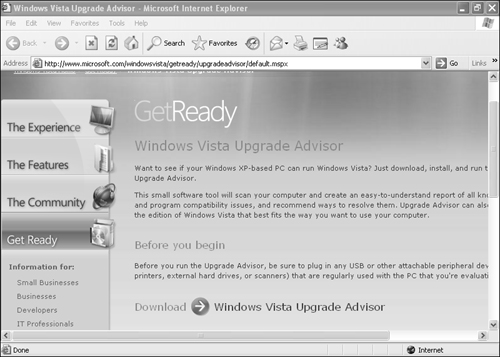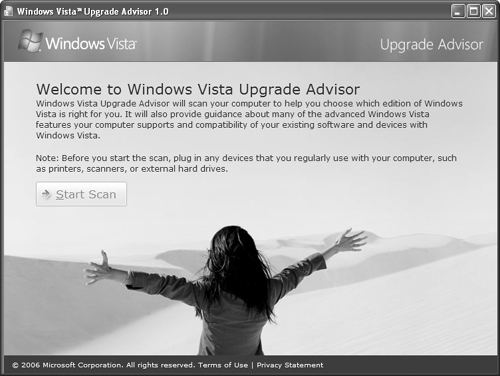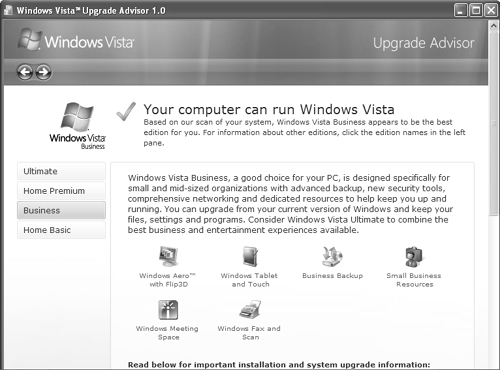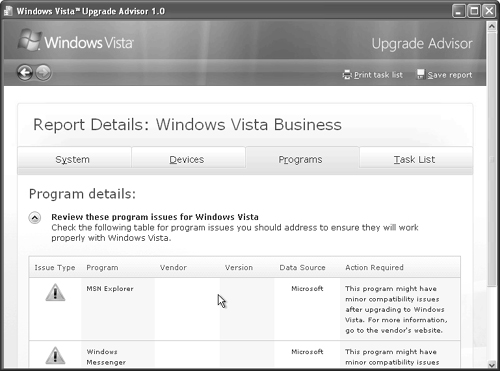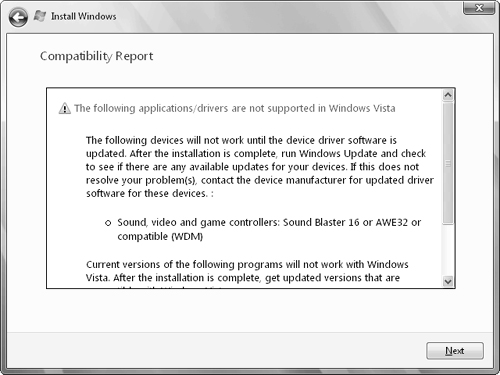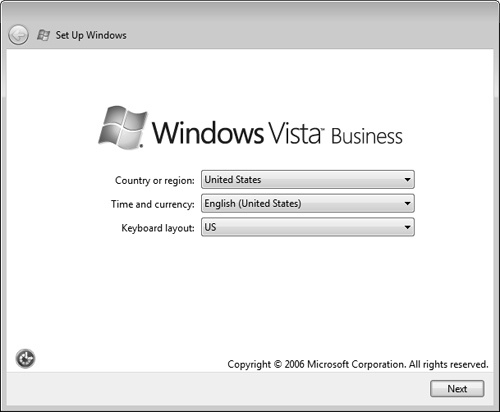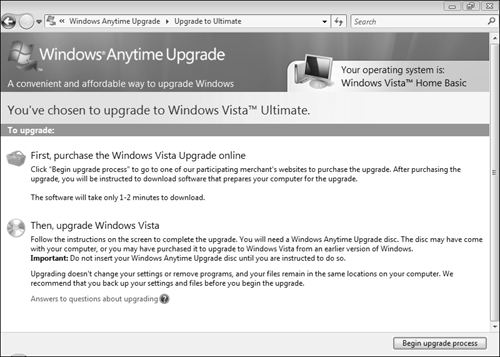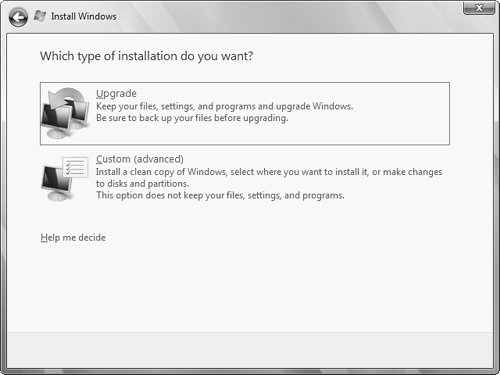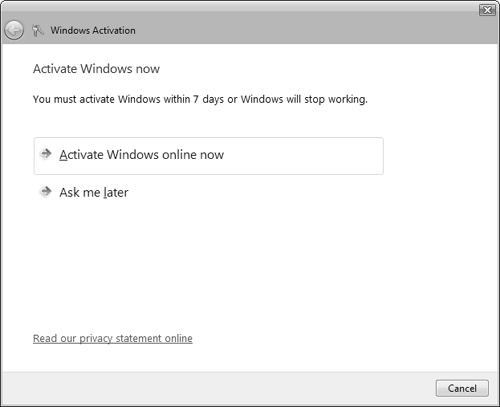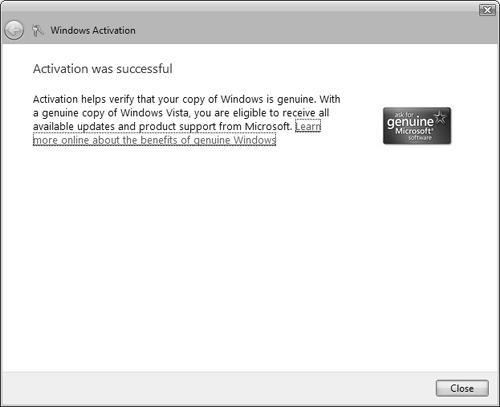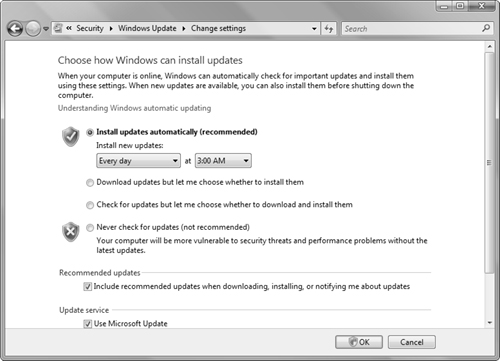This chapter helps you to prepare for the exam by covering the following Microsoft-specified objectives for the Installing and Upgrading Windows Vista section of the TS: Microsoft Windows Vista, Configuring exam:
Upgrade to Windows Vista from a previous version of Windows.
<objective>Microsoft provides several upgrade paths for computers running versions of Windows XP. This objective is included to ensure that you know how and when to upgrade Windows XP to Windows Vista.
</objective>Upgrade from one edition of Windows Vista to another.
<objective>Several paths are available for upgrading from one edition of Windows Vista to another edition. This objective is included to ensure that you know how and when to upgrade from one edition of Vista to a higher edition.
</objective> </feature>Outline
As Microsoft introduces new versions of its Windows operating system, many users around the world want to take advantage of the features included in the new version without purchasing new computers. Consequently, Microsoft has made available upgrade paths that enable users to upgrade older versions of Windows. By upgrading earlier versions of Windows to Windows Vista, you can retain registry settings and account information contained in the older operating system.
Many users are attracted by the features available in higher editions of Vista, such as Vista Ultimate, but may have purchased a computer on which a lower edition of Vista such as Home Basic has been pre-installed. Consequently, Microsoft has made upgrade paths available that enable these users to upgrade to a higher version of Vista. As with the upgrade of an earlier version of Windows, these upgrade paths enable users to retain registry settings and account information from the lower version of Vista.
Objective: Upgrade to Windows Vista from a previous version of Windows.
Upgrade paths from previous Windows versions depend on the operating system version currently installed. Table 3.1 lists the available upgrade paths for older operating systems.
Table 3.1. Upgrading Older Operating Systems to Windows Vista
Operating System | Upgrade Path |
|---|---|
Windows XP Home Edition | Can be upgraded directly to Windows Vista Home Basic, Vista Home Premium, Vista Business, or Vista Ultimate. |
Windows XP Professional | Can be upgraded directly to Windows Vista Business or Vista Ultimate. |
Windows XP Media Center | Can be upgraded directly to Windows Vista Ultimate. |
Windows 9x/ME Windows NT 4.0 Workstation Windows 2000 Professional | Cannot be upgraded. You need to perform a clean installation of Windows Vista |
Non-Windows operating systems (Unix, Linux, OS/2) | Cannot be upgraded. You need to perform a clean installation of Windows Vista. |
Note: Upgrading Windows 2000 and older computers
Theoretically, you can upgrade Windows 98/Me/NT 4.0/2000 computers to Windows XP and then upgrade to Vista. However, the licensing costs for such an upgrade would be higher than that of purchasing a clean copy of Vista; besides, such older computers probably would not meet Vista’s hardware requirements.
In addition to running one of the supported versions of Windows mentioned here, a computer to be upgraded to Windows Vista must meet the hardware requirements outlined in Chapter 2, “Installing Windows Vista.” In addition, all hardware components should be found in the Windows Logo Program for Hardware. Older software applications also may not be compatible with Windows Vista. Such applications might need to be upgraded or replaced to work properly after you have upgraded your operating system. Review the information provided in Chapter 2 when preparing your computers for upgrading to Windows Vista.
Microsoft includes a compatibility tool on the Windows Vista DVD-ROM that generates reports describing hardware and software components that might not be compatible with Windows Vista. This report identifies any hardware or software problems associated with the computer to be upgraded.
Step by Step 3.1 shows you how to obtain a system compatibility report from the computer to be upgraded.
Before you upgrade a Windows XP computer to Windows Vista, you should perform several additional tasks, as follows:
Check the BIOS manufacturer’s website for any available BIOS upgrades, and upgrade the computer’s BIOS to the latest available functional version if necessary. You should perform this step before a clean install or an upgrade to Windows Vista.
Scan and eliminate any viruses from the computer, using an antivirus program that has been updated with the latest antivirus signatures. You should then remove or disable the antivirus program because it may interfere with the upgrade process. In addition, you should use a third-party program to scan for and remove malicious software (malware).
Install any upgrade packs that may be required to render older software applications compatible with Windows Vista. Consult software manufacturers for details.
Install the latest service pack for Windows XP (SP2 at the time of writing), plus any other updates that Microsoft has published.
Exam Alert: Vista requires the NTFS file system
Whether you are performing a clean installation or upgrading a Windows XP installation to Vista, remember that the partition on which you install Vista must be formatted with the NTFS file system. An exam question could specify that you are upgrading a computer containing an installation of Windows XP on a FAT or FAT32 partition. In such a case, you must execute the convert c: /fs:ntfs command from XP before beginning the upgrade.
After you have checked system compatibility and performed all tasks required to prepare your computer for upgrading, you are ready to proceed. The upgrade takes place in a similar fashion to a new installation, except that answers to some questions asked by the setup wizard are taken from the current installation. Step by Step 3.2 shows you how to upgrade a Windows XP Professional computer to Windows Vista Ultimate.
Exam Alert: Uninstalling Windows Vista
If you should decide that you must revert your computer to Windows XP after upgrading to Vista, you must back up all data, reformat your system disk, and reinstall XP from scratch. Unlike Windows XP, which offered an uninstall option in Control Panel Add or Remove Programs after upgrading from Windows 98/Me, no such uninstall option is available in Vista. You might encounter an exam question asking you how to remove Vista after an upgrade.
As in previous versions of Windows, you can install Windows Vista alongside a different version of Windows in a dual-boot configuration. By selecting Custom (Advanced) instead of Upgrade in step 6 of Step by Step 3.2, you can select a different partition on which to install Windows Vista. This retains all applications and settings you have configured in the previous version of Windows and creates a clean installation of Vista on the partition you have specified. You can even create multi-boot systems with more than two different operating systems, including different editions of Vista, on the same computer. Dual-booting or multi-booting has the following advantages:
You can test various editions of Vista without destroying your current operating system.
If you are running applications that are not compatible with Vista, you can boot into an older operating system to run these applications.
Developers can test their work on different Windows versions without needing more than one computer.
Windows Vista introduces several new boot management programs, which replace the older programs used with Windows NT/2000/XP/Server 2003. These include the following:
Bootmgr.exe—. Controls boot activities and displays a boot manager menu on a dual-boot or multi-boot computer.Bcdedit.exe—. An editing application that enables you to edit boot configuration data on Vista. This is the only program that offers boot management editing capabilities for Vista.Winload.exe—. The operating system loader, included with each instance of Windows Vista or Windows Server 2008 installed on any one computer.Winload.exeloads the operating system, its kernel, hardware abstraction layer (HAL), and drivers on startup.Winresume.exe—. Included with each instance of Windows Vista or Windows Server 2008 installed on any one computer, this program resumes the operating system from hibernation.
For additional details on multi-booting Windows Vista with other operating systems, refer to “Boot Configuration Data in Windows Vista” in the Suggested Readings and Resources section at the end of this chapter.
Exam Alert: When multi-booting, install the oldest operating system first
If you are setting up a dual-boot or other multi-boot system, install the oldest operating system first. For example, you would install Windows 2000, then Windows XP, and then Windows Vista in that order if you wanted a triple-boot configuration with these three operating systems. If you fail to do so, the newer operating system will be unable to start after you have installed an older operating system. An exam question could give you several choices of the sequence in which you might install multiple operating systems.
Caution: Remember disk file system issues
If you need to dual-boot Windows Vista with operating systems earlier than Windows 2000, remember that these older operating systems only support certain file systems. Windows 98/Me support FAT and FAT32 file systems, and Windows NT 4.0 supports FAT and NTFS file systems. If you need Vista plus one of these operating systems to read the same data, ensure that your data is located on a partition formatted with one of these file systems. Also ensure that Windows NT 4.0 has at least Service Pack 5 (SP5) installed. However, remember that the partition on which you install Vista must be formatted with the NTFS file system.
Objective Upgrade from one edition of Windows Vista to another edition.
Chapter 1, “Introducing Windows Vista,” introduced you to the editions Microsoft has produced for Windows Vista. Just as you can upgrade Windows XP to Vista, you can also upgrade a lower edition of Vista to a higher one. Table 3.2 summarizes the available upgrade paths.
Table 3.2. Upgrading One Edition of Vista to a Higher One
Windows Edition You Are Upgrading | You Can Upgrade to This Edition |
|---|---|
Vista Home Basic | Vista Home Premium Vista Ultimate |
Vista Home Premium | Vista Ultimate |
Vista Business | Vista Ultimate |
Vista Enterprise | Vista Ultimate |
Vista Ultimate | Cannot be upgraded further |
Note: Vista Enterprise is available only to volume users
Microsoft makes the Enterprise version of Windows Vista available only to Enterprise Agreement (EA) or Software Assurance (SA) customers, who must purchase a minimum of 250 Vista licenses. You can only install Vista Enterprise as a clean installation. Smaller businesses should deploy Vista Ultimate if they need the enhanced features available to Vista Enterprise.
The Windows Vista DVD-ROM contains the code for all editions of Vista. When you enter the license key, this tells Setup which edition of Vista you are installing. As mentioned in Chapter 2, you can also install Vista without entering a license key and then select the desired edition. Doing so enables you to preview the capabilities of a given edition before making a purchase decision. Microsoft recommends that you perform several procedures before installing Vista, regardless of the method used for installation.
Follow Step by Step 3.3 to upgrade Windows Vista Home Basic to Vista Ultimate. Other possible upgrades (as outlined previously in Table 3.2) are performed in much the same fashion.
Exam Alert: The Windows.OLD folder
When you upgrade a previous version of Windows to Vista, Setup.exe stores copies of the previous operating system subfolders and files in the Windows.OLD folder, so that they are available in case you need them. This also happens if you perform an in-place upgrade or reinstallation of a Windows Vista system. You might encounter an exam question that asks you what happens to these files.
Performing Post-Installation Updates and Product Activation
Chapter 2 introduced the concept of product activation, and it explained how Microsoft uses activation to combat software piracy. Even though you activated your computer running Windows XP, you are required to activate your product again after upgrading to Vista. You should note that product activation (which is required) is not the same as registration (which is optional). Windows operates at reduced functionality after the grace period unless you activate the product. Registering your copy of Windows Vista allows you to receive updates and other offers from Microsoft and provides ready information to Microsoft tech support personnel should you ever need their services.
If you entered your product key during installation or upgrading, Vista is automatically activated three days later. You can activate Vista sooner if you desire. Follow Step by Step 3.4 to complete product activation.
If you are not connected to the Internet, you can telephone a customer support representative at Microsoft. Select the option to generate an installation ID that you can give to the support representative, who will provide you with a confirmation ID that you type into the activation wizard to complete the procedure.
Updates, hotfixes, and patches are designed to repair specific problems that are uncovered from time to time after the release of a new operating system or major update such as a service pack. Their purpose is to correct security-related or performance-related problems and maintain the operating system in an up-to-date condition at all times. Microsoft operates the Windows Update website that analyzes your computer and determines which updates are required to keep your computer up-to-date and downloads and installs these updates automatically. These updates take place in the background while you are working on other projects and inform you if a restart is needed. If this is so, you can schedule the restart so that it does not interfere with completion of your work.
When you install or upgrade to Windows Vista and select the option to download updates at the time of installation, your operating system is up-to-date with all patches and hotfixes at that time. Microsoft releases additional updates on a periodic basis (generally monthly on the second Tuesday of each month). Automatic Updates is turned on by default at installation time so that you will receive these updates as they are made available. However, this feature provides several settings that enable you to manage how you receive and install these updates.
The Automatic Updates feature in Windows Vista enables computers to automatically connect to the Microsoft Windows Update website and download the latest updates, hotfixes, and patches. You can specify how and when your computers are updated, and updates can be downloaded and installed in the background while you are working.
To configure options for automatically receiving updates, follow the procedure outlined in Step by Step 3.5.
Administrators can configure Automatic Updates for all computers in an Active Directory domain or organizational unit (OU) by means of Group Policy, which offers the same options as outlined here. In this way, you can ensure that all computers automatically receive the required updates. In addition, you can specify that the client computers download their updates from a server running Windows Server Update Services (WSUS) on your network. By doing so, you can reduce the Internet bandwidth required for downloading updates, and you can test updates in a lab environment to ensure that they do not cause problems with services or applications on the client computers.
Tip: Visit the Windows Update website regularly, even if you have configured Automatic Updates
The Windows Update website downloads only high-priority and recommended updates in an automatic manner. This site also contains optional software and hardware updates, which can help improve your computer’s performance.
Always test the updates on one or more computers that are representative of your production computers in a lab environment before rolling out the updates.
In this chapter, you learned how to upgrade previous versions of Windows to Windows Vista and how to upgrade from one edition of Vista to a higher one. You learned about the requirements for upgrading previous versions and the tasks that you should perform before you upgrade a computer.
You can upgrade computers running Windows XP to editions of Windows Vista, and you can upgrade certain editions of Vista to higher ones. You cannot upgrade computers running Windows 2000 or older to Vista and must perform a clean installation if you wish to perform such an upgrade.
You also reviewed the method of performing product activation and looked briefly at how to keep your computer up-to-date with Windows Update.
You have seen the conditions under which older Windows operating systems can be upgraded to Windows Vista. Here you upgrade a computer running Windows Vista Business to Vista Ultimate without first having entered a product key for Vista Business. To perform this exercise you should have a computer on which you have installed Vista Business using methods outlined in Chapter 2 but without entering a Vista Business product key.
As mentioned in Chapter 2, you can install Vista without a product key if you want to evaluate the features of a given edition of Vista. You can then upgrade to another supported edition by entering the product key of the upgraded edition. This procedure is also useful in learning situations and when preparing for Microsoft exams. Estimated Time: 45–90 minutes, depending on the speed of your hardware.
|
D and E. You can upgrade Windows XP Home Edition or Windows XP Professional to Windows Vista Business. Microsoft does not support upgrades of older operating systems or of Windows Vista Home Basic or Home Premium to Vista Business, so answers A, B, C, and F are all incorrect. For more information, see the sections, “Upgrading to Windows Vista from a Previous Version of Windows,” and, “Upgrading from One Edition of Windows Vista to Another.” | |
B. Ellen should check her hardware for compatibility. The Windows Vista Upgrade Advisor utility will do this for her and will produce a report of any hardware or software issues that may interfere with her ability to upgrade to Vista. If she performs a clean installation of Windows Vista Business, she will not retain her applications or settings, so answer A is incorrect. She should not upgrade her computer to Windows Vista Ultimate because this upgrade will also fail; moreover, upgrading to Vista Business is a supported upgrade option. Therefore answer C is incorrect. While she should disable her antivirus software before upgrading to Vista, she will not receive this error if she hasn’t done so; therefore, answer D is incorrect. For more information, see the section, “Vista Upgrade Advisor.” | |
C. Peter should run the Windows Vista Upgrade Advisor. He can download this application by selecting the Check Compatibility Online option from the Install Windows screen that appears when he inserts the Vista DVD-ROM. The | |
A. Kristin should select the Custom (advanced) installation option to install Vista on the second partition and format this partition with the NTFS file system. If she selects the Upgrade option, she upgrades her installation of Windows XP to Windows Vista, so answers B and D are incorrect. If she does not format the partition with the NTFS file system, the installation will fail, so answer C is incorrect. For more information, see the section “Dual-Booting Windows Vista.” | |
D. The Windows Vista Upgrade Advisor analyzes the hardware and software components of the computer for compatibility issues. You should run this utility before attempting to upgrade your computer to Vista. You should not purchase new hardware or download new drivers before you have run the Upgrade Advisor because it is always possible that these components are compatible with Vista. Therefore answers A and C are incorrect. The Easy Transfer Wizard is used to transfer files and settings from an older computer to a new Windows Vista computer. It does not check hardware compatibility, so answer B is incorrect. For more information, see the section, “Vista Upgrade Advisor.” | |
B. Antivirus (AV) software is known to cause problems during installation of or upgrading of Windows operating systems. On the first reboot, these programs may falsely report that the installation files contain a virus and halt the installation. You should uninstall the AV software and disable any AV checking in the computer’s BIOS before installing or upgrading to Vista. You can always re-enable or reinstall antivirus software after you have completed the upgrade. The computer is not actually infected with a virus, so Tom does not need to reboot to Windows XP or scan for viruses, so answer A is incorrect. The Check Compatibility Online option is used to check a computer for software or hardware incompatibility before upgrading to Windows Vista. These problems do not cause the false reporting of a virus, so answer C is incorrect. | |
A. On a computer that is running Windows XP Professional, you can either upgrade the current Windows installation by installing Windows Vista on the same partition holding the current Windows operating files or create a dual-boot system by installing Windows Vista on a different partition. You do not upgrade Windows XP in this scenario because you installed to a different partition, so answer B is incorrect. This type of installation does not wipe another instance of Windows out, nor does it fail for this particular reason, so answers C and D are incorrect. For more information, see the section, “Upgrading to Windows Vista from a Previous Version of Windows.” |
The following are some recommended readings on the subject of upgrading to Windows Vista:
Books
McLean, Ian and Orin Thomas. MCTS Self-Paced Training Kit (Exam 70-620): Configuring Windows Vista Client. Redmond, WA: Microsoft Press. 2007.
Course
Microsoft Official Curriculum course 5115, Installing and Configuring the Windows Vista Operating System. Module 2, Upgrading and Migrating to Windows Vista Ultimate Edition. Information available at http://www.microsoft.com/learning/syllabi/en-us/5115aprelim.mspx.
Websites
Microsoft. Boot Configuration Data in Windows Vista. http://www.microsoft.com/whdc/system/platform/firmware/bcd.mspx
Microsoft. Log Files that are Created When You Upgrade to Windows Vista from an Earlier Version of Windows. http://support.microsoft.com/kb/928901
Microsoft. Windows Vista Upgrade Advisor. http://www.microsoft.com/windowsvista/getready/upgradeadvisor/default.mspx
Microsoft. Upgrade Paths from Previous Versions. http://www.microsoft.com/windowsvista/getready/upgradeinfo.mspx
Microsoft. System Requirements for Windows Vista. http://support.microsoft.com/kb/919183
Microsoft TechNet. Boot Configuration Data Editor Frequently Asked Questions. http://technet2.microsoft.com/WindowsVista/en/library/85cd5efe-c349-427c-b035-c2719d4af7781033.mspx?mfr=true
TechRepublic. Running the Windows Vista Upgrade Advisor on a New Computer by Greg Shultz. http://articles.techrepublic.com.com/5100-10877_11-6152876.html?tag=nl.e132.

